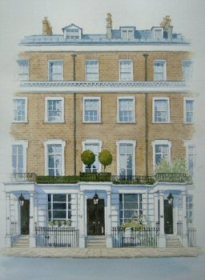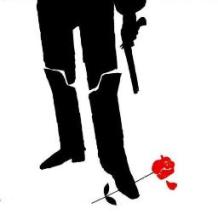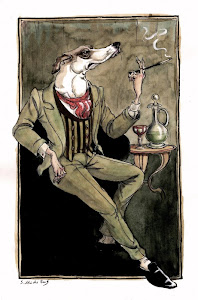 Meet the "young fogeys" of David Cameron's Britain.
Meet the "young fogeys" of David Cameron's Britain.by Emily Witt
Foreign Policy, 16 Septembre 2010
Young fogeys wear tweed, smoke pipes, and revere the monarchy. They fight to repeal the Hunting Act, carry handmade umbrellas, and evince nostalgia for a past they have never actually experienced. Their political sensibilities, for the most part, track their aesthetics: Sharpe, a former chairman of the Cambridge University Conservative Association, describes his own politics as "paternalistic."
Fogeyism has no manifesto or ideology, Sharpe insists, and young fogeys don't announce themselves as such -- to do so would be counter to what Sharpe has called their "studied indifference." But, he admits, "one thing that is of great concern is the overdemocratization of things at the moment -- that whatever is popularly thought good is what's good." The young fogey, says Sharpe, has faith in authority: Bach is superior to Lady Gaga; Alberti is preferable to Frank Gehry; and police chiefs should be appointed, not elected. As the ruling Conservatives present their agenda of government decentralization and sweeping budget cuts on relatively tenuous political ground, this refusal by some young conservatives to adhere to the party's reformed image is inconvenient at best.
...
The first use of "young fogey" to describe this particular subculture dates from May 1984, when Alan Watkins, a columnist for the conservative magazine the Spectator, wrote the following taxonomy: "He is a scholar of Evelyn Waugh. He tends to be coolly religious. ... He dislikes modern architecture. He makes a great fuss about the old Prayer Book, grammar, syntax and punctuation. He laments the difficulty of purchasing good bread, Cheddar cheese, kippers and sausages. ... He enjoys walking, and travelling by train." The "he" was likely intentional -- although many young women had fogeyish views, a tweed suit was rarely considered a flattering costume for most of them.
British newspapers quickly popularized the term and applied it to a range of authors, politicians, and academics. A guide, The Young Fogey Handbook, edited by Suzanne Lowry, appeared in 1985, the same year that British miners called off a yearlong strike and pundits proclaimed an ideological victory for Thatcher's government. The handbook noted that "the present resurgence of Young Fogey ties up neatly with the re-invention of the class system" and added, with some acidity, that the trend was "locked into the great and incurable English vice of snobbery: explicit in the instant wish of any man who makes a bob or two, or rises in his profession, to ride to hounds, to send his children to [private] school and to live behind a facade." The fogey was not necessarily of the upper class, but he did seem to revere it.
According to The Young Fogey Handbook, the 1980s culture of young fogeys was delineated by subtle clues, ranging from the novelists one read (Evelyn Waugh and P.G. Wodehouse topped the list), to the leisure pursuits one enjoyed (rambling, croquet, beagling, crosswords), to the contemporary horrors that one considered suitable targets for cantankerous letters to conservative periodicals (Greenpeace, pop music, the 1960s). The original Evelyn Waughnabes preferred to distance themselves from the vulgar machinations of everyday politics. A few tea-stained and fraying fogeys even modeled themselves after social realists such as George Orwell. Still, they did, as a cohort, lean decidedly to the right: Many of them were self-identified libertarians who viewed even Thatcher with disdain.
Like preppy culture in the United States, young fogeyism had waned by the 1990s. The incorporation of many conservative ideas into the platform of New Labour was one factor; another was that formerly marginal opinions -- cherishing traditional British cuisine, say, or protecting the BBC from becoming too commercial -- became more mainstream. The fogeys also may have had an image problem at a time when acting posh was unpopular and hereditary peers were losing their places in the House of Lords. Even the foibles of the Prince of Wales -- who had once referred to a modern extension of the National Gallery as "a monstrous carbuncle on the face of a much-loved and elegant friend" and whom the Handbook called "the Superfogey" -- seemed more cantankerous than charming as he reached middle age.
In 2003, the Spectator ran an article titled "The Young Fogey: An Elegy" that declared the end: "Twenty years after his creation, the Young Fogey has pedalled off into the sunset on his sit-up-and-beg butcher's bike, broad-brim fedora firmly on head, wicker basket strapped to the handlebars by leather and brass ties."
©2009 Washingtonpost.Newsweek Interactive, LLC
http://www.foreignpolicy.com/articles/2010/09/16/waughnabes?page=full





















3 comments:
I've been called many things in my life, usually a word that starts with a b and ends with an h. But if I declare that Bach is better than Lady Gaga, which of course we all know is true, can I be called a middle aged female fogey? Oh I do hope so!
i wear tweed, would smoke pipes if it were healthy, i have a handmade umbrella. agree as well that bach is better than gaga but i am strongly for the hunting ban and a fierce democrat, atheist and smile at the monarchy.
fogeys who take themselves seriously can't be taken seriously but kudos to their style of choice. chapeau. *curtsies*
nice blog mister!
Altho' they may be fogies, the detail in the picture indicates the reason for the bowler hats and suits ... they are the official judges of the hounds in the ring behind, with the Huntsman and Whippers-In hunting coats.
The requirement of a judge is that s/he knows her/his hounds ... (not necessarily that s/he was educated out of the state system) and therefore are usually also Masters, or Huntsmen of other packs, foxhounds or beagles.
Post a Comment